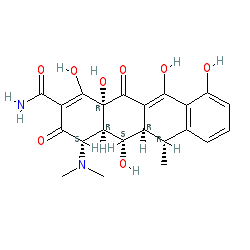|
Synonyms: BMY-28689 | Monodox® | Vibramycin®
doxycycline is an approved drug (FDA (1967), UK (2000))
Compound class:
Synthetic organic
Comment: Doxycycline is a tetracycline based antibacterial. It has been repurposed as a low-potency human metalloprotease inhibitor for periodontitis and is also used as an antimalarial therapy.
There are a number of salt forms in PubChem. The chemical structure we show here matches that of the consensus structure in PubChem, listed in the links table below. The DrugBank, ChEBI, ChEMBL and PDB entries for doxycycline show a different structure. Doxycycline is one of the key access group antibacterials on the World Health Organization's Model List of Essential Medicines (link provided in the Classification table, under the Summary tab below). The Malaria tab on this ligand page provides additional curator comments of relevance to the Guide to MALARIA PHARMACOLOGY. Ligand Activity Visualisation ChartsThese are box plot that provide a unique visualisation, summarising all the activity data for a ligand taken from ChEMBL and GtoPdb across multiple targets and species. Click on a plot to see the median, interquartile range, low and high data points. A value of zero indicates that no data are available. A separate chart is created for each target, and where possible the algorithm tries to merge ChEMBL and GtoPdb targets by matching them on name and UniProt accession, for each available species. However, please note that inconsistency in naming of targets may lead to data for the same target being reported across multiple charts. ✖ |
|
|||||||||||||||||||||||||||||||||||
| No information available. |
Summary of Clinical Use  |
| Doxycycline is used to treat a wide range of bacterial infections. These include acne, urinary tract infections, intestinal infections, eye infections, gonorrhea, chlamydia, periodontitis (gum disease), lesions caused by rosacea, anthrax, and to treat infections resulting from by mite, tick, or lice infestations. It is also used to prevent malaria (particularly useful in areas where chloroquine or multidrug-resistant P. falciparum are found) and as an effective treatment for severe malaria, when used as a combination therapy [6]. It should not be used as a monotherapy for malaria treatment due to a delayed antimalarial effect (see MOA for more details). Marketed formulations may contain doxycycline hyclate or doxycycline monohydrate. |
Mechanism Of Action and Pharmacodynamic Effects  |
| Antibacterial MMOA is reversible binding to the 30S ribosomal subunits to block binding of aminoacyl tRNA to mRNA and thereby inhibit bacterial protein synthesis. Human MMOA is pan-MMP inhibition but some specificity for MMP7and MMP8 is evident, and is associated with reducing inflammation and elevated levels of proinflammatory cytokines. In Plasmodium, pharmacological concentrations of the compound kill the parasite in the lifecycle after treatment starts. It is thought that doxycycline inhibits the production of proteins encoded by the apicoplast genome, leading to a subsequent loss of apicoplast function and a possible explanation for the delayed antimalarial effect [2-3]. |
External links  |
|
For extended ADME data see the following: Electronic Medicines Compendium (eMC) Drugs.com |










